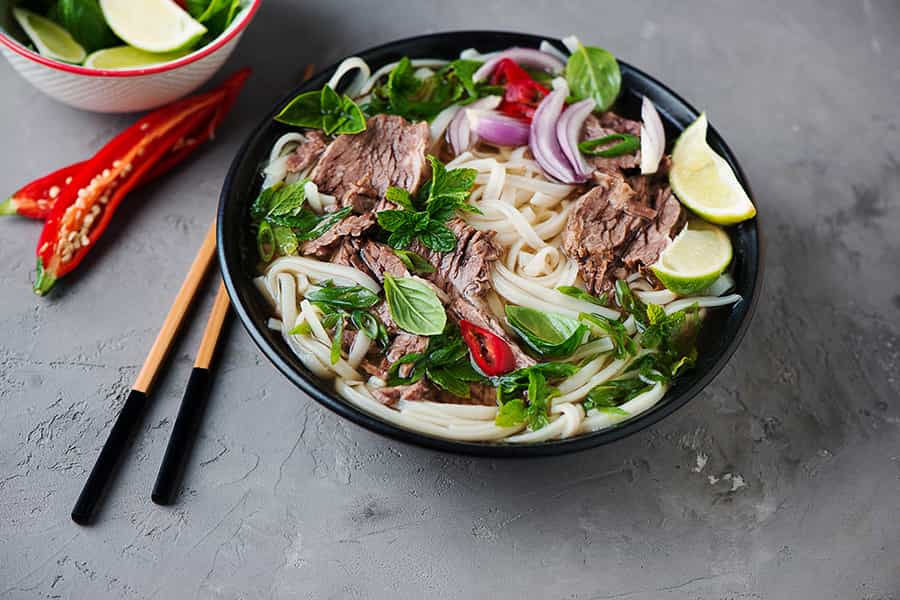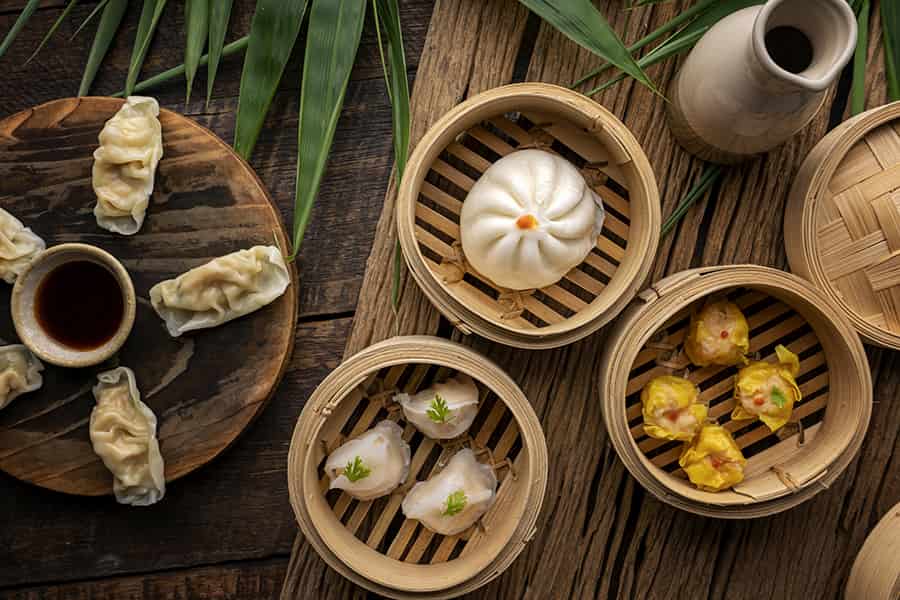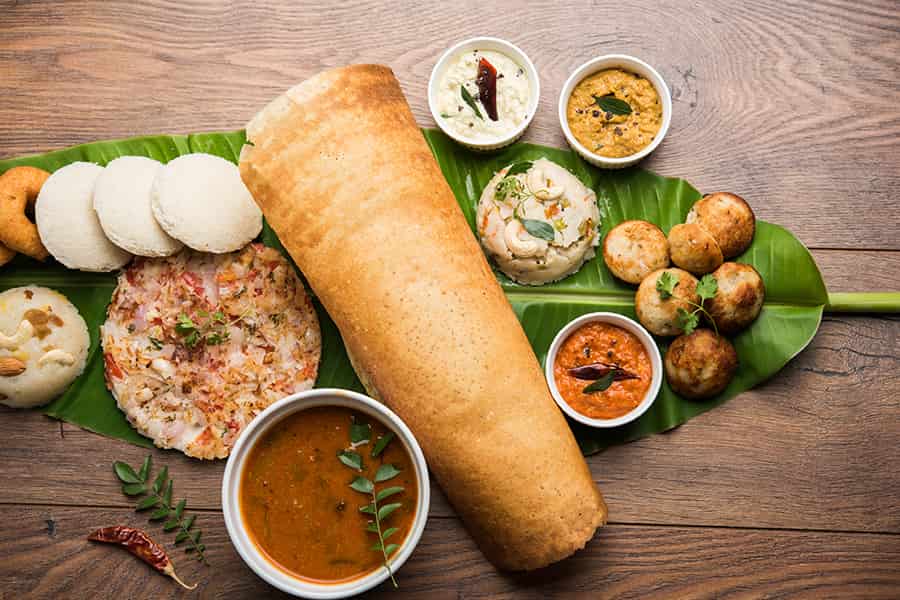International travel may be off the cards right now, but that doesn’t mean you can’t enjoy exploring in your own kitchen. If you’re feeling a bit restless, why not discover new cultures and flavours by cooking a delicious new dish? While most of us are familiar with spaghetti bolognese and a nice Balti, when it comes to foreign cuisine there are so many great-tasting dishes out there that most of us haven’t even scratched the surface with.
From the Louisiana-inspired jambalaya to Indonesian nasi goreng, we’ve put together a list of mouthwatering meals from around the world to get you inspired. Some you may have eaten before, some you may have only heard of – and others may be brand new. One thing’s for sure though – they’re all delicious.
1. Nasi Goreng (Indonesia)

Most people who have been to Bali will be familiar with nasi goreng – because it’s absolutely everywhere! Locals eat it throughout the day – at food stalls by the side of the road, in restaurants, and in their own homes. ‘Nasi goreng’ means fried rice, and while no-one is disputing the delicious simplicity of plain fried rice, nasi goreng is a seriously amped up version of this comfort food. As it’s often made with leftover ingredients, nasi goreng can vary quite a lot, but the rice is usually always served with spring onions, shallots, garlic, chilli, cucumber and tomatoes, and a fried egg on top.
Aside from the additional ingredients, the thing that really sets nasi goreng apart from ‘normal’ fried rice is its wonderfully deep, salty-yet-sweet flavour. The sauce is made with kecap manis, which is an Indonesian sweet soy sauce that caramelises the rice when it’s heated. Combined with pungent spice paste and shrimp paste, the overall flavour packs a punch: it’s fresh, hot, and fragrant. Protein usually comes in the form of the egg, but other sources are sometimes added – usually tempeh, an Indonesian food made from fermented soybeans. You can buy tempeh in most supermarkets, though you can always add chicken or tofu if you prefer.
Part of the beauty of nasi goreng is its flexibility. Because it’s typically made with leftovers, you can throw in whatever you have in the fridge – peas, carrots, green beans, mushrooms, spinach. You can also make it as simple or as elaborate as you like. If you like getting creative in the kitchen, you can knock up your own spice paste and have fun trying all the different individual flavours – and if you’re looking to just knock up a quick meal, you can buy a spice paste from a supermarket. You can find out how to cook the perfect nasi goreng here, or watch the video below. To make the dish fully plant-based, just omit the shrimp paste and egg, and add some tofu or tempeh, if you like.
2. Pho (Vietnam)

It wasn’t too long ago that only visitors to Vietnam would be familiar with pho – but thanks in part to the popularity of UK restaurant Pho, this delicious noodle soup is fast becoming a favourite over here. Pho (pronounced “fuh”) is the Vietnamese national dish, and it’s beloved all over the country. It’s a dish that perfectly encapsulates Vietnam’s diverse background. Thought to have been inspired by Chinese ingredients like rice noodles, star anise and ginger, and the French dish pot au feu, it’s the perfect blend of flavours and textures. In one mouthful you get slippery noodles, crunchy bean sprouts, spicy chilli, fragrant fresh herbs, and an exquisitely spiced clear broth.
Traditional pho is made with a complex beef stock that’s cooked for hours – usually eight to 14 hours to infuse all the flavours. And there are lots of flavours – aside from the beef, the stock contains charred onions or shallots, star anise, ginger, garlic, cinnamon sticks, cloves, and sometimes cardamom, depending on where in Vietnam you are. For protein, beef or crispy tofu are usually used, and then Thai basil, fresh coriander, spring onions, mint and raw bean sprouts are added to the bowl. Pho is eaten with chopsticks, and it’s perfectly acceptable to slurp as you eat – which is handy for those of us who aren’t too good with chopsticks! When you’ve finished the noodles, you can drink the remaining broth right from the bowl – it’s so tasty it would be a crime to pour it away!
If you want to make traditional beef pho, try this recipe here – or you can make a veggie alternative, here. While traditional pho can take hours (even days!) to make, you can make quick versions too. Have a watch of the video below to find out more.
3. Smørrebrød (Scandinavia)

If you think sandwiches are just for lunch, picnics, or to grab as an on-the-go snack, think again. Smørrebrød are Scandinavian open-sandwiches that have become a culinary art form. Originating in Denmark – the word Smørrebrød comes from the Danish words for butter (smør) and bread (brød) – they’re popular all over Scandinavia. Though they started out as a lunchtime meal, they’re also eaten as a quick-yet-satisfying dinner that uses up whatever you have in the fridge. They’re the perfect vehicle for leftovers, as you can put almost anything on them.
Traditionally, though, smørrebrød is made with dense Danish-style rye bread – and because this bread is typically fermented, it’s got a tasty tang to it. Then, the bread is primed with a thick layer of butter before the toppings are piled on. Toppings are almost always local Danish ingredients – often fresh seafood like shrimp, salmon, and pickled or fermented herring, though meat and vegetarian smørrebrød are also popular. Some of the most traditional smørrebrød toppings include shrimp with lemon and cress, herring with onions and chives, salmon with mustard and dill, potato salad with a boiled egg, blue cheese with sliced pear, and roast beef with horseradish.
Whatever you choose to put on your bread, it’s important to embellish your smørrebrød with garnishes that enhance the taste, texture and overall look. Traditionally smørrebrød has a good crunch – so feel free to add plenty of pickles, raw onion, cucumber, radishes, etc. Fresh herbs like dill, chives and cress are also good to add, as is a wedge of lemon. The one rule that all Danes follow, regardless of what ingredients are used, is that smørrebrød is never eaten by hand. It’s customary to eat it with a knife and fork, savouring every mouthful. Feeling inspired? You can learn how to build your own smørrebrød here – or watch the video below for more smørrebrød ideas.
4. Tacos (Mexico)

Almost everyone likes a good taco – but the tacos most of us are familiar with are typically inspired by the US. Traditional Mexican tacos don’t include garnishes like lettuce, tomato, cheese or sour cream. Instead, they’re topped with fresh coriander, finely chopped white onion, salsa, guacamole, a squeeze of lime, and sometimes some sliced radish. Those crunchy yellow taco shells you buy in a box are also an American invention, and in Mexico, tacos are almost always served in soft corn tortillas. While we might think of ground beef as a traditional taco filling, once again, that’s a US creation. Mexican tacos are generally fresher, healthier, and far more delicious.
Wherever you are in Mexico, tacos are everywhere. They’re the ultimate street food, and while you can eat them in sit-down restaurants, they’re usually served from street stalls and carts. Tacos are either made fresh by the vendor themselves, or bought from a local tortilleria. Some of the most popular Mexican tacos are taco pastor (made with marinated pork), seafood tacos (usually made with breaded white fish), tacos asada (made with steak), and taco carnitas (made with shredded pork). While most tacos involve meat, there are plenty of veggie tacos available too – usually made with roasted vegetables like peppers, squash or courgettes. You can have a go at making your own tacos asada here – or to make some veggie tacos, try this recipe here instead. To see how tacos are made by experts, check out the video below.
5. Dim sum (China)

Technically dim sum isn’t a dish – it’s several. Originating in China, dim sum is a large range of small Cantonese dishes. Traditionally eaten on Sundays and at Chinese New Year, dim sum is enjoyed slowly, with each dish being shared out. It’s often a family experience, and in China, families go out on a Sunday to eat dim sum and drink jasmine tea together. The words dim sum mean “touch the heart”, and the story goes that it was created centuries ago by chefs of the Chinese Royal Court, in order to “touch the heart” of the emperor. The focus for this meal is savouring the food and the company; dim sum is meant to be nibbled, not gobbled – no matter how delicious it is!
There are many different types of dim sum, but almost all menus contain steamed fluffy white buns, rice noodle rolls, and dumplings. Steamed buns are usually filled with a mixture of barbecued pork and shallots, or mushrooms, vegetables and herbs, and – because sweet sits alongside savoury during dim sum – sweet custard buns, too. Delicate steamed dumplings are stuffed with pork and prawns, or mushrooms and water chestnuts. Rice noodle rolls are large sheets of rice noodles rolled up with a variety of fillings – usually prawns, pork or vegetables, served with a splash of soy sauce.
Other popular dim sum dishes include sticky rice wrapped in lotus leaves, sesame prawn toast, turnip cake, sesame seed balls, stuffed peppers and aubergine, spring rolls, and radish cakes, which are steamed and then pan-fried. Because there are so many dim sum dishes, they can be enjoyed by everyone – whether you’re an omnivore, a vegan, or gluten-free. Have a look at some popular dim sum dishes here, or get inspired by watching Hong Kong’s top chef make shrimp and chive dumplings below.
6. Masala dosa (India)

There’s no denying that we Brits love Indian food – so much so that the tikka masala is widely considered our national dish. But most of us aren’t quite as familiar with Southern Indian cuisine. One of the most popular Southern Indian meals is masala dosa, a crispy, savoury pancake made from rice and lentils that’s stuffed with mashed potatoes, onions, green chillies and plenty of spices. It’s often served with aromatic chutney and sambar, a lentil-based vegetable stew, and is an enormously popular dinner, breakfast, or hearty snack. Dosa dishes have been eaten since the fifth century, and masala dosa in particular is treasured for its complex flavours, textures, aromas and visual appeal.
While stuffed crepe type dishes generally aren’t too healthy, masala dosa is an exception: because the batter is made from rice and lentils it’s protein packed and low in cholesterol – and because it’s typically fermented, it’s even healthier. Traditional masala dosa batter is fermented overnight, but you can make a quick batter by mixing chickpea flour, wholewheat flour, baking soda, salt and water, and frying up in a pan until you have a crispy, golden pancake. Each bite of masala dosa is a joy: crisp pancake, fluffy potatoes, crunchy onions, hot spices, sweet chutney… these crepes have everything going on. Masala dosas don’t contain any animal products, so they’re a great choice if you’re trying to eat more plant-based food. You can make a traditional fermented masala dosa here – or if you’re short on time, you can try this quick version, here. Or, watch the video below if you want some extra tips and tricks..
7. Tagine (Morocco)

The tagine is arguably Morocco’s national dish, and it’s certainly the country’s most famous culinary offering. A tagine is a slow-cooked stew that takes its name from the cone-shaped clay pot that it’s cooked in. Tagines are an important part of Moroccan culture, and cooking in ceramic pots has been documented as early as the ninth century. The tagine pot was created as a portable oven, and it was first used by nomadic tribes across North Africa. The cone-shaped lid of the tagine traps heat and steam, so you don’t have to use much water to cook your stew – and because the cooking process is very slow, the food is infused with wonderfully deep flavours.
So what goes into a tagine? Typically, a tagine is a rich stew of vegetables and meat or fish. Spices are very important, and turmeric, cinnamon, saffron, ginger, and cumin are all tagine staples. Dried fruit, nuts, olives, preserved lemons and fresh herbs are all key ingredients, and couscous is often served on the side. There are dozens of tasty tagine recipes you can try, depending on your taste buds: chicken and apricot tagine, chickpea and carrot tagine, and lamb and prune tagine are all popular in Morocco.
You can buy tagine pots on Amazon*, though you can make a tagine in a slow-cooker if you don’t want to buy a new pot. You can have a look at some tagine recipes here, or make sure you get your five-a-day by checking out Jamie Oliver’s seven-veg tagine below.
8. Jambalaya (USA/Caribbean)

Fusion food is almost always exciting. Combining different flavours and different cuisines can lead to delicious new traditions – and jambalaya is a great example of this. Originating in Louisiana, USA, and considered to be the ‘national dish’ of New Orleans, jambalaya brings together flavours from France, Spain, West Africa, North America and the Caribbean. It’s essentially a rice dish with vegetables and meat or seafood, and it’s absolutely jam packed with flavour. There are many different types of jambalaya, but traditional dishes are based on the key ingredients of Creole and Cajun cooking: onion, green pepper, celery, garlic, and jalapeño chillies. Jambalaya is simple comfort food at its best, and because it’s a one-pot meal, it’s effortlessly easy to make.
There are two main types of jambalaya: Creole and Cajun. The main difference is that Creole jambalaya (also known as “red jambalaya”) uses tomatoes while Cajun jambalaya doesn’t. The seasoning is the most important part, and you can make your own seasoning by mixing garlic powder, onion powder, paprika, smoked paprika, thyme, oregano, basil, cayenne pepper, salt and pepper – or you can just buy Creole seasoning pre-made. Louisiana jambalaya typically contains seafood like shrimp, crayfish, or prawns, and sometimes also includes sausage or chicken. Because the key flavours of jambalaya come from the spices, it’s easy to make a delicious veggie version too: just swap the meat or fish for some beans, peas or mock-meat, if liked.
Why not have a go at making the perfect shrimp jambalaya here? Or to make a vegetarian alternative, try this recipe here. To see how to make a classic New Orleans jambalaya, you might want to watch the video below.
Final thoughts…
Although visiting exotic locations isn’t possible at the moment, this doesn’t mean we can’t bring the flavours of foreign countries into our own homes. Aside from discovering new cuisines and enjoying a delicious dish, cooking has many powerful benefits. It’s relaxing, therapeutic, and an expression of self-love – as well as being a great way to show affection to friends and family. It also leads to more balanced eating, encourages you to try a wider variety of food, and allows you to become more mindful about what you eat.
At a time when many of us are prioritising our health and wellbeing, and feeling keen to try new things, there’s never been a better time to get creative in the kitchen. If you’re looking for some further inspiration, then check out the food and drink section of our site.